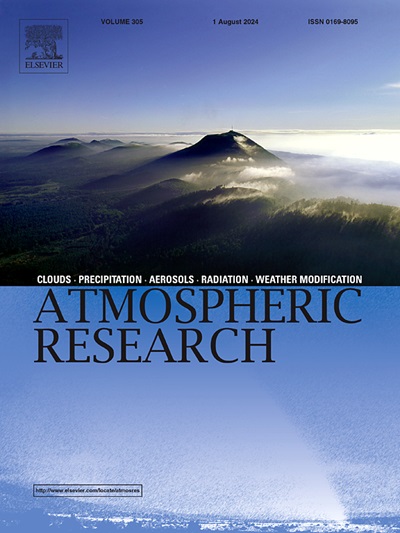Key characteristics and statistical investigation of new particle formation events at a Mediterranean site
IF 4.5
2区 地球科学
Q1 METEOROLOGY & ATMOSPHERIC SCIENCES
引用次数: 0
Abstract
New particle formation (NPF) events were investigated at a coastal suburban site (Chania, Greece) in eastern Mediterranean during May 2022–April 2023. The particle number size distribution was measured together with particulate matter (PM10) and gaseous pollutants (NO, NO2, O3). 16 NPF events (8 Class I and 8 Class II) were observed with higher occurrence on May (5 events), whereas no NPF event took place on winter months. On the other hand, 15 undefined events were identified with a higher number of events present in February. Increased frequency on warm months was associated with enhanced biogenic and photochemical activity. The average condensation sink, the formation and growth rate for all events was 0.007 s−1, 0.16 cm−3 s−1 and 2.60 nmh−1 respectively, without statistically significant differences between Class I and Class II events. The formation and growth rates were higher during the warm period. Nucleation particles (14 nm – 25 nm) preserved no seasonal variations but were significantly increased on periods with NPF activity. NPF activity was enhanced by the presence of condensable sinks that favored nanoparticle formation. Both the growth and the formation rates were positively correlated with solar radiation, temperature and wind speed. Two main factors were identified during NPF events: atmospheric conditions (solar radiation, temperature, wind speed and condensation sinks) and the urban environment (NO). NO2, O3 and PM10 were not associated with nucleation particles and NPF activity.
地中海某地新颗粒形成事件的主要特征和统计调查
本文于2022年5月至2023年4月在地中海东部沿海郊区(希腊Chania)研究了新粒子形成(NPF)事件。测量了颗粒物(PM10)和气态污染物(NO, NO2, O3)的粒径分布。共观测到NPF事件16起,其中ⅰ类事件8起,ⅱ类事件8起,5月发生率较高(5起),冬季月份未发生NPF事件。另一方面,15个未定义事件被确定为2月份出现的事件数量较多。在温暖月份增加的频率与增强的生物和光化学活性有关。所有事件的平均凝结汇、形成和生长速率分别为0.007 s−1、0.16 cm−3 s−1和2.60 nmh−1,I类和II类事件之间无统计学差异。暖期形成和生长速率较高。成核颗粒(14 nm ~ 25 nm)没有季节变化,但随着NPF活性的增加而显著增加。有利于纳米颗粒形成的可凝汇的存在增强了NPF活性。生长速率和形成速率均与太阳辐射、温度和风速呈正相关。确定了NPF事件的两个主要影响因素:大气条件(太阳辐射、温度、风速和冷凝汇)和城市环境(NO)。NO2、O3和PM10与成核颗粒和NPF活性无关。
本文章由计算机程序翻译,如有差异,请以英文原文为准。
求助全文
约1分钟内获得全文
求助全文
来源期刊

Atmospheric Research
地学-气象与大气科学
CiteScore
9.40
自引率
10.90%
发文量
460
审稿时长
47 days
期刊介绍:
The journal publishes scientific papers (research papers, review articles, letters and notes) dealing with the part of the atmosphere where meteorological events occur. Attention is given to all processes extending from the earth surface to the tropopause, but special emphasis continues to be devoted to the physics of clouds, mesoscale meteorology and air pollution, i.e. atmospheric aerosols; microphysical processes; cloud dynamics and thermodynamics; numerical simulation, climatology, climate change and weather modification.
 求助内容:
求助内容: 应助结果提醒方式:
应助结果提醒方式:


